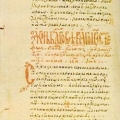Saxons in the medieval court
 Donauschwaben, or German settlers are often associated with the Banat region and the Austro-Hungarian Empiore. However, German settlers and craftsmen have been active in Serbia much earlier and much deeper inside of Medieval Serbia. They had settlements in Kosovo and the Kopaonik (e.g. Rogozna) mountains and share a rich history with the local population throughout the centuries. Instead of calling them Donauschwaben they are referred to in Serbian as "Sasi" or "Sasoni" which literly translates into Saxons.
Donauschwaben, or German settlers are often associated with the Banat region and the Austro-Hungarian Empiore. However, German settlers and craftsmen have been active in Serbia much earlier and much deeper inside of Medieval Serbia. They had settlements in Kosovo and the Kopaonik (e.g. Rogozna) mountains and share a rich history with the local population throughout the centuries. Instead of calling them Donauschwaben they are referred to in Serbian as "Sasi" or "Sasoni" which literly translates into Saxons.
Raška (Serbia) has a long history of diversity and relations with foreign kingdoms. Even in medieval times the Serbian kings hired craftsmen from all over Europe. The most wanted were Saxons, which had a substantial presence in medieval Serbia as early as 1230 AD. They were of such importance that Serbia's emperor, Stephen Uroš IV Dušan the Mighty, mentioned them in the famous Codex of Dušan.
It mentions them by name in article 123 as following: